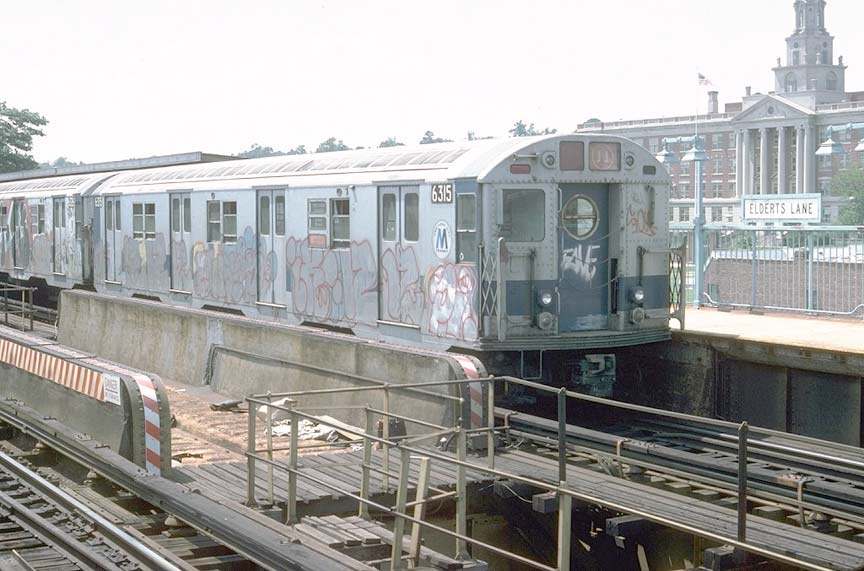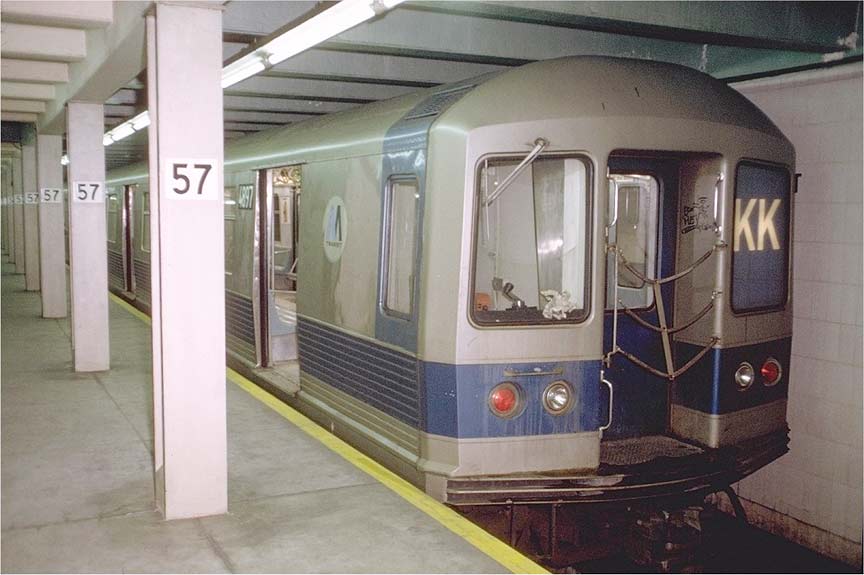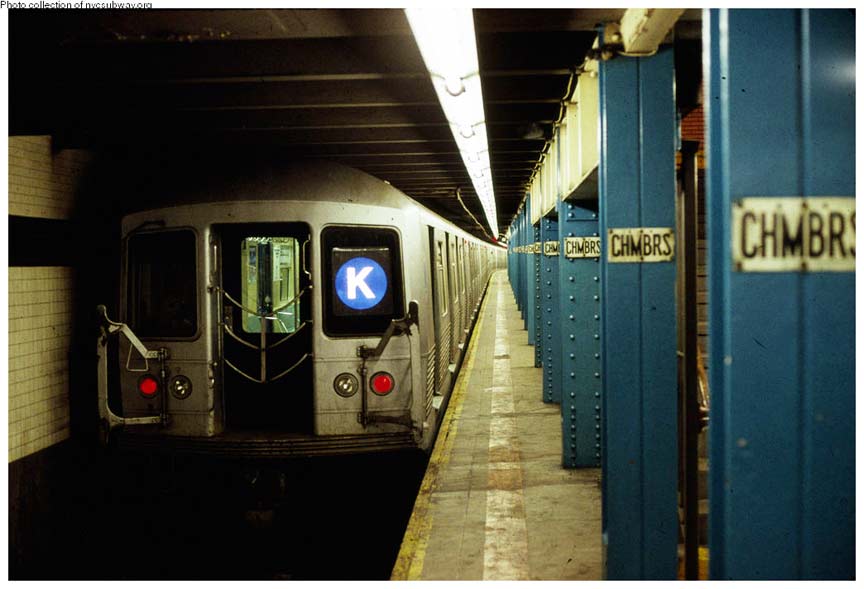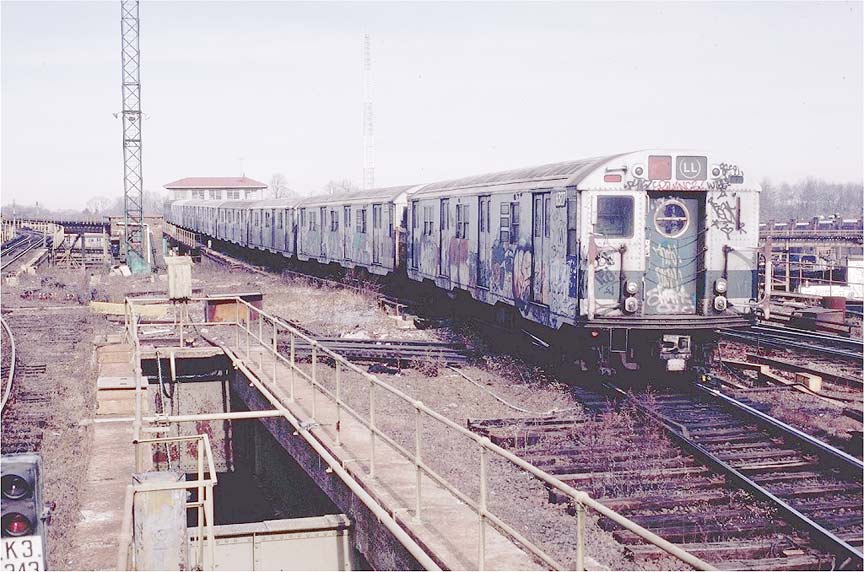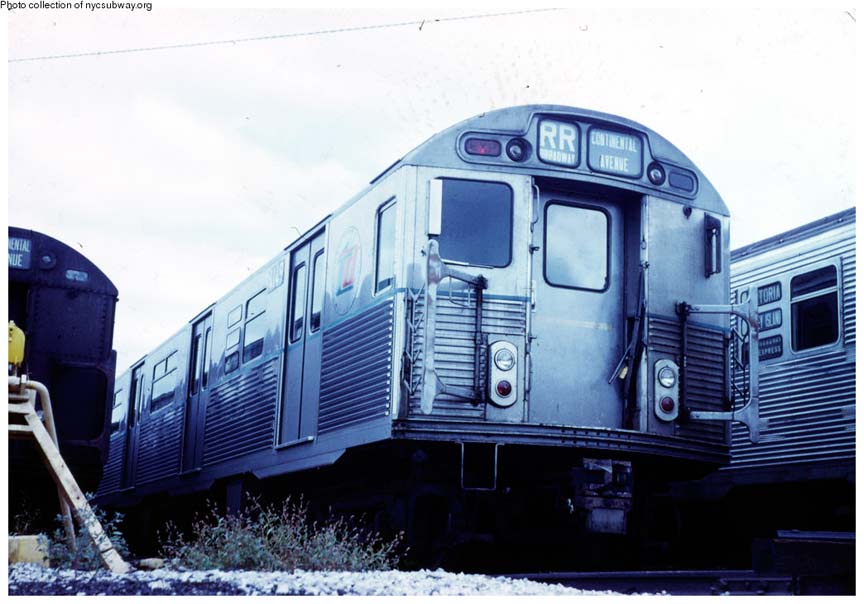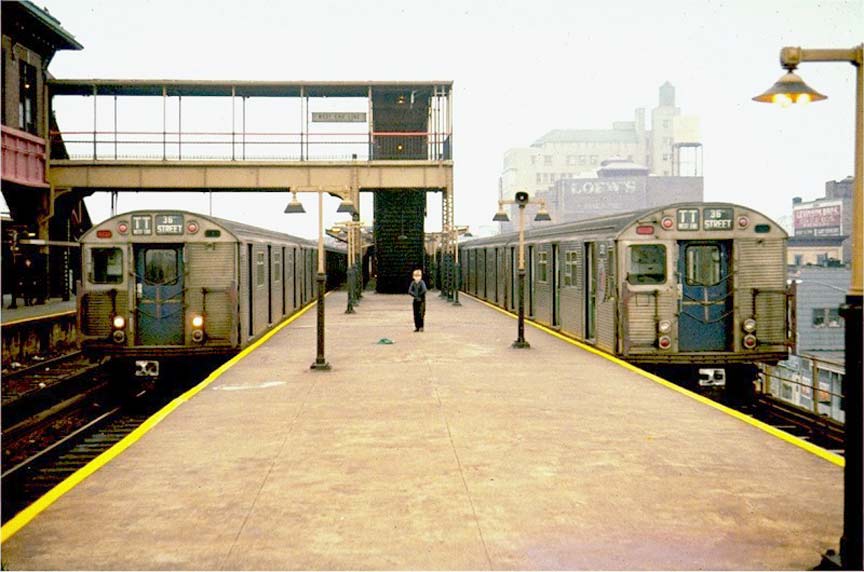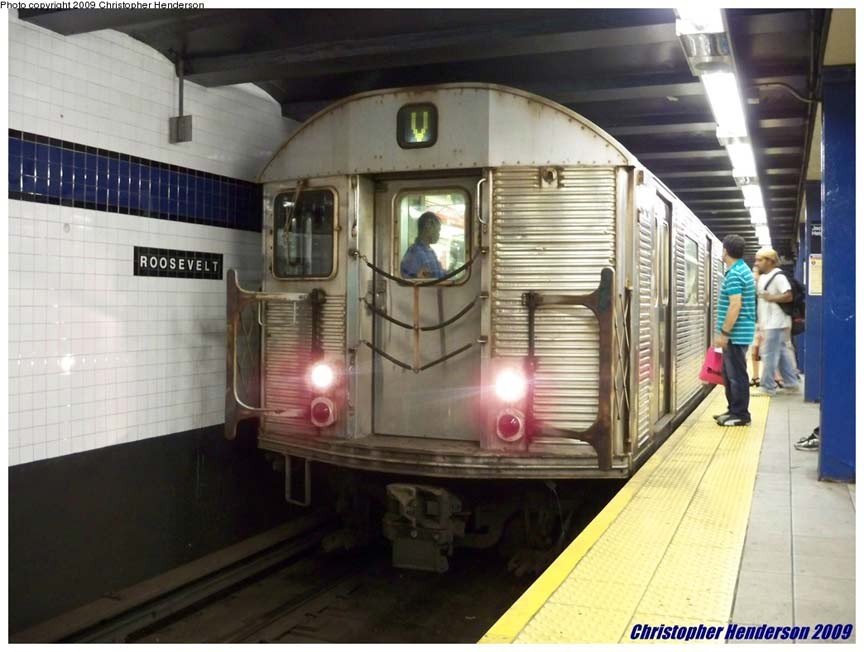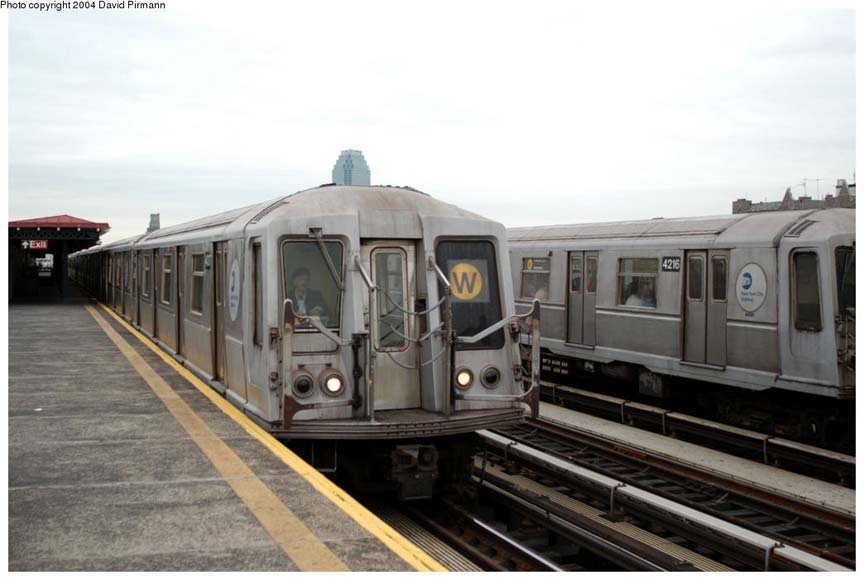In 1977 a set of R16 cars with #6315 bringing up the rear during the Great Age of Graffiti displays a JJ sign. Note Franklin K. Lane High School at right, and a black on white enamel station sign. Until the Unimark system was adopted for subway signage, there were a hodgepodge of different styles to be seen throughout the transit network.
The Jamaica Local JJ designation was used for just a few months, from November 27, 1977 to July 30th, 1978. It was a skip stop service, similar to the Z train today.
The KK train was the MTA’s method of connecting the Jamaica, Queens El with the 6th Avenue IND line. The new Chrystie Street tunnel connection made this possible, and the new KK local went into service between 57th Street and 6th Avenue and the now-demolished 168th Street el terminal on July 1, 1968. This service contiuned until 1973 when the KK was cut back to the East New York transfer complex. After the KK, which was renamed the K, ended service in 1976, the Chrytsie Street connection wasn’t used for passenger service until 2010 (see below). Here we see a set of R40 cars headed by #4897 idles at 57th Street. In 2009 many R40s were retired, and the remaining cars will be phased out in 2010.
Perhaps some experts can answer this: I don’t know why the 1968-1976 KK/K’s used blue roll signs — if they ran on 6th Avenue, they should have used the orange 6th Avenue signs.
Update: prior to 1979 the MTA employed a different color scheme to differentiate individual lines.
Some R40s featuring car # 4921 stops at Crescent Street on the Jamaica El in 1972.
Though the Transit Authority/MTA has shown a reluctance to recycle or revive letters, the K was once again used — this time on the 8th Avenue line — when the AA local train (see above) was renamed the K on May 5, 1986. The return of the K to active service was short-lived, however, and it was retired on December 11, 1988, with the C assuming local duties on the 8th Avenue in Manhattan. This is another R40 trainset idling at Chambers Street. On the 8th Avenue line, the blue sign makes more sense.
With the coming retirement of the W, that means the two letters that are your webmaster’s initials — K and W — have likely reached the end of permanent use in the subways. (Not so fast! See below)
An R16 trainset headed by car #6327 plies the Canarsie Line outside the Atlantic Avenue station in 1980, during the Great Age of Graffiti. One of the BMT’s most venerable routes, the Canarise Line represents a legacy of the Brooklyn and Rockaway Beach steam railroad, built in 1865 between East New York and Canarsie, Brooklyn. The line was “ellified” and electrified on an overhead trestle along Van Sinderen Avenue in 1906. Though the line used surface tracks between Glenwood Road and the Jamiaca Bay terminal, the route was cut back to its present terminal in 1913, with a transfer provided to trolleys that ran on a private right of way; the trolley ended service in 1942, and it is represented today by the B42 bus.
In 1916 the Dual Contracts plan funded the huge el interchange at East New York, and a ramp was built enabling Canarsie Line trains to enter the Broadway El line over the Williamsburg Bridge as well as the now-defunct Fulton Street line; over the years, the Transit Authority offered Broadway-Canarsie service now and then, but there is no active service using this connection at present. The new 14th Street BMT line (named the 14, 16 and 17 lines) reached East New York in 1928, connecting with the Canarsie El at that time. The 16 became the LL in 1967, and became the L on May 5, 1986.
An R32 trainset led by car #3878 idles in the Coney Island Yards sometime in the 1970s. I’m being deliberately vague because I haven’t found anything regarding the MM line, which, I’d imagine, was an iteration of the M. Perhaps it was active at the same time as the JJ line shown above.
Joe Korman: The MM was an alternative to the KK in 1968 as a local to 57/6th. When the Chrystie St planning was underway, they weren’t sure whether more folks would be from Metropolitan/Myrtle or the actually used KK from 168th Jamaica. 57th/6th opened in July 1968.
The MJ, meanwhile, was the Transit Authority’s designation for the Myrtle Avenue El, which ran above the lengthy Brooklyn-Queens route from April 10, 1888 to October 4, 1969. The MJ was renamed from the BMT 11 in 1967, but like the #8 Third Avenue El, the cars never displayed an MJ sign: the Q-type wooden cars in use on the el never had roll signs.
There has never been an NN local service, as the N runs all-local on the depressed Sea Beach open cut from 59th Street in Brooklyn south to Coney Island. In 1969, a set of R38s picks up passengers at the 8th Avenue station.
The Transit Authority, however, had a brief flirtation with express service on the Sea Beach, a line curiously constructed in 1915 without express platforms, making every station a local stop. The authority experimented with the express NX between Brighton Beach and 57th Street and 7th Avenue in Manhattan beginning soon after a new Manhattan Bridge connection allowed the 4th Avenue BMT to travel up Broadway and 7th Avenue, beginning November 27, 1967. The line was a bust and was removed on April 12, 1968. Thought was given to a track switch, allowing stops at 86th Street, Avenue U and Kings Highway, but such an arrangement proved unworkable. Like the express Culver tracks, the express Sea Beach tracks now remain unused except for work trains.
Though a black and white “P” appears on MTA R32 and R38 rollsigns the Transit Authority/MTA has never assigned the letter P, or O, for that matter, to any line. During LIRR strikes, the MTA had a plan ready to run a P train from Jamaica via the Williamsburg Bridge up the 8th and 6th Avenue lines to 168th Street/Washington Heights. There has not yet been a need to implement the route.
The Q train, which presently runs from Brighton Beach to 57th Street and 7th Avenue in Manhattan, and its iterations the QB, QJ and QT, form among the more complicated of letter designation stories.
Here we see an R16 set led by car #6333 at Avenue J on the Brighton Line; the QJ ran local service between the old 168th Street Jamaica el terminal to Brighton Beach employing the Broadway el, Williamsburg Bridge, the Nassau Street line, the Montague Street tunnel, and the Brighton line. The QJ was eliminated in favor of the J in 1972 and the J didn’t venture onto the Brighton for several decades, though reroutes have seen it turning up there again in early 2010.
There were many interminglings of QJ and QB service over the years, but in general in the 1960s, the QB ran between Brighton Beach and 57th Street using the Manhattan Bridge connection to the Broadway Line. Today’s Q matches this route, though the Q had flirtations with the 6th Avenue Line from 1988-1995 and again from 1999-2001.
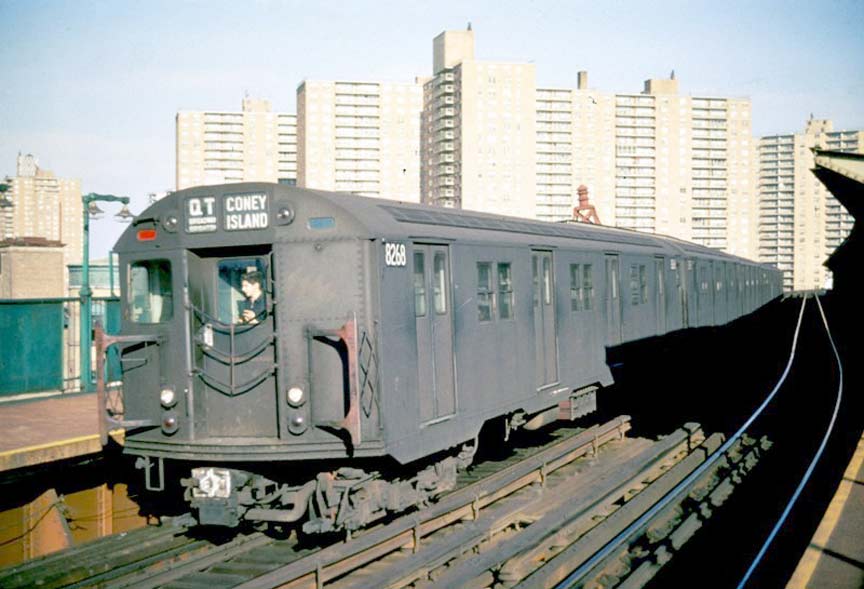 Meanwhile the QT train ran, in general, between the Stillwell Avenue Coney Island terminal to Ditmars Boulevard in Astoria between 1960 and 1967. The new Q route, whihc will be replacing the W, will begin revisting Astoria in mid-2010. Here a set of R30s led by car #8268 passes the West 8th Street station with Trump Village in the background.
Meanwhile the QT train ran, in general, between the Stillwell Avenue Coney Island terminal to Ditmars Boulevard in Astoria between 1960 and 1967. The new Q route, whihc will be replacing the W, will begin revisting Astoria in mid-2010. Here a set of R30s led by car #8268 passes the West 8th Street station with Trump Village in the background.
The RR, or the 4th Avenue BMT line, runs up Broadway in Manhattan and alternately to Astoria and Continental Avenue in Forest Hills, using the Queens Boulevard IND line via the 60th Street tunnel connection. Unlike most other subway lines it is in a tunnel the whole time, never emerging to an open cut or el.
The Fourth Avenue was built in 1915 and originally ran only between 86th Street and Chambers Street. A connection was made with Whitehall Street in 1918, and it was extended to 57th Street in 1919 and then to Lexington Avenue in 1920, and following World War II, to Astoria in 1949. Designated the BMT #2 for much of its history, the line became the “RR,” probably standing for “railroad,” in 1960, dropping the extra R on May 5, 1986.
The RR had always kept a route to Chambers Street on the Nassau Street Line which it employed from time to time. In the late 70s and 80s I recall the rush hour R specials to the Nassau line; between 1967 and 1968 these trains had their own RJ designation. The old Nassau specials were discontinued in 1987.
Following the terrorist destruction of the WTC on 9/11/01, the Broadway line was out of commission for several weeks, and the J train did yeoman’s work filling in for the R, using the Montague Street tunnel connection and allowing it to run south to 95th Street. ABOVE: an idling R38
A brown Diamond R exists on some rollsigns. It was used briefly to designate the Nassau Line rush hour specials (Nassau Line trains use brown signs), and sometimes turns up on the regular R trains to this day as a mistake.
The MTA plans to use the letter T for the still-under-construction Second Avenue Subway, but they will have to do some recycling — the TT and the T have been used already.
Originally known as the West End Short Line, and then the 3B, the TT ran from 36th Street in Sunset Park, using the West End el tracks over New Utrecht Avenue, 86th Street and Stillwell Avenues to Coney Island. The TT also ran from Times Square and Chambers to Coney Island during its run. Above: a pair of R32 trainsets idle at the Stillwell terminal.
 The T was the express version of the TT, using the West End line. The TT/T designation ended in 1967, to be displaced by the B until 2001, when the D took over the West End. Here are a second pair of R32s on the West End line.
The T was the express version of the TT, using the West End line. The TT/T designation ended in 1967, to be displaced by the B until 2001, when the D took over the West End. Here are a second pair of R32s on the West End line.
The much-maligned, soon to be deceased, V arrives at Roosevelt Avenue on the Queens Boulevard line, using a soon to be retired R32 trainset. So, catch the R32s and the V train while you can! The V train, using the new 63rd Street connection and later the 53rd street tunnel with the Queens Boulevard line, originated on December 16, 2001 and ran from Continental Avenue in Forest Hills to 2nd Avenue, buddying up with the E and F along the way, and along with the G and R, formed the Queens Boulevard “gravy line.” The MTA wanted to add a new service on Queens Boulevard to alleviate crowding, but found instead people will tolerate crowding as long as they didn’t have to deal with plodding local service the V provided.
An R42 trainset led by car #4644 idles at the southern V terminus at 2nd Avenue. By the end of June 2010, the V designation will disappear and the M will get a new lease on life and in the process become the second subway line with two Queens terminals (an earlier version of the E train had terminals at 179th Street in Jamaica and the Rockaways). The M will use the Broadway Brooklyn el and the Williamsburg Bridge as it always has, but instead of heading south on the Nassau Street, 4th Avenue and West End lines, will instead turn north, using the reactivated Chrystie Street connection to 6th Avenue and then run out to Continental Avenue, in the process buddying up with the B, D, E, F and R and replacing the V. The M will then change from the brown livery of the Nassau Street line to the snappy orange of the 6th Avenue. The V will contemplate the glory that never was.
I’ll miss the W — for one thing, the line was among the last bastions of the R40 ‘slant’ trains, as seen here on the Astoria Line. The W originated in 2001 and originally ran from Ditmars Boulevard south to Coney Island, employing the West End line. It was shaved back to Whitehall Street in 2004, and will be ‘demised’ in June 2010, with the Q extended north to help out the N.
2/19/16 — with the addition of the Second Avenue Subway scheduled for late 2016, the Q train will be employed there. To replace it in Astoria, the MTA will reintroduce the W and run it from Whitehall Street to Ditmars Blvd.
The diamond W was used on occasion when the W used the express tracks in Astoria. The bullet W and diamond W will soon be joining the 8, 9, AA, BB, CC, EE, GG, JJ, LL, MM, MJ, NX, QB, QJ, K, KK, T, TT and V in the MTA’s penalty box, perhaps never to get on the field again.
Page completed May 9, 2010
Your webmaster Kevin Walsh: erpietri@earthlink.net
©2010 FNY

